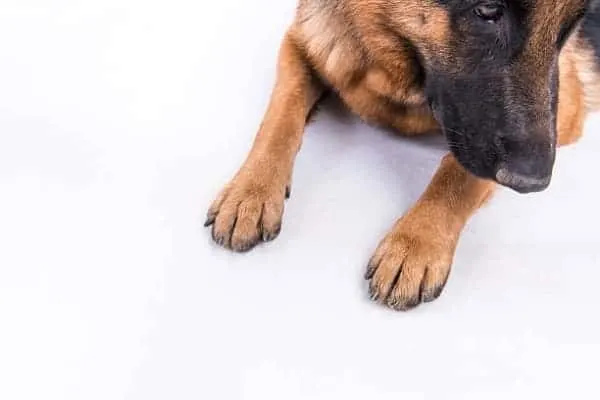Do German Shepherds Have Webbed Feet?
Many German Shepherd owners have noticed that their dogs love the water and swim exceptionally well, making it easy to assume that part of what makes them strong swimmers would be webbed feet.
Do German Shepherds have webbed feet? The answer may surprise you.
The American Kennel Club’s official standard of the German Shepherd Dog does not include webbed paws.
The German Shepherd paws are described as follows: “The feet are short, compact with toes well arched, pads thick and firm…”
However, there will always be breeders who stray from the official breed standard, resulting in some German Shepherds having webbed feet.

Why Does My German Shepherd Have Webbed Feet?
When referring to the breeding and bloodlines of dogs, all dogs can be sorted into two categories: pet quality and show quality.
If you purchased your German Shepherd from a breeder who actively shows with their German Shepherds, and your puppy’s parents were registered with the American Kennel Club, you would have a “show quality” dog.
If you purchased your German Shepherd from a breeder who was not showing their dogs and your puppy’s parents were not registered with the American Kennel Club, or they were breeding mixed breed dogs, you likely are the proud owner of a “pet quality” dog.
All dogs are equally amazing and important, no matter what their family tree looks like; these terms are simply technical and they do not mean anything negative.
While most rescue dogs are pet quality, it is possible to rescue or adopt a show quality dog too.
German Shepherds who have webbed paws would be considered pet quality, due to the deviation from the American Kennel Club’s breed standard.
If a show quality German Shepherd breeder happens to have a puppy born into one of their litters who has webbed paws, they likely would be unable to show the dog, as he would not match the breed standard.
Therefore, they would advertise the puppy as a pet quality puppy and likely reduce the price.
Technically, there is nothing wrong with the puppy and he would make an amazing companion; he simply would be disqualified from showing due to the webbing.

What breeds of dogs have webbed paws?
According to Rover, most dogs do have slight webbing between their paws, which you can observe if they will allow you to spread their paw out and look.
Most dogs do not have very much webbing, but some dogs were bred specifically to have webbed paws as a result of the jobs that they helped their people do.
According to Adrienne Farricelli, a dog trainer who writes for Dog Discoveries, the following breeds of dogs were bred to have webbed paws:
- Labrador Retrievers
- Newfoundlands
- Portuguese Water Dogs
- Chesapeake Bay Retrievers
- Otterhounds
- Nova Scotia Duck Tolling Retrievers
- American Water Spaniels
- Weimaraners
- Redbone Coonhoods
- German Wire-haired Pointers
- Dachshunds
Do webbed paws offer an advantage?
According to Daily Dog Stuff, webbed paws do offer dogs advantages.
The webbing creates a larger surface area to paddle through the water, which similarly to a kayak paddle, helps a dog make the most of every stroke.
Webbed paws also help dogs navigate through muddy terrain better, as the webbing can help prevent their paws from sinking into the mud.
Webbing also allows dogs to dig more effectively.
Considering the German Shepherd’s history boasting many military heroes and search and rescue heroes, it is surprising that webbed paws are not a part of the breed standard; their average jobs would utilize this trait well.

Do webbed paws create any unique medical concerns?
Dogs may get yeast or bacterial infections in the folds and creases between their paw pads.
If a dog spends a lot of time in water and their paws are not dried off, the moisture that remains between the paw pads can cause the bacteria that naturally reside on their skin to overpopulate, causing an uncomfortable infection.
Dogs with webbed paws have a higher chance of getting a paw infection, as the webbing causes their paws to stay wet longer and reduces the airflow between the paw pads, creating an environment that bacteria like to grow in.
If your German Shepherd has webbed paws, be sure to clean them out regularly by moistening a paper towel or washcloth and cleaning between each paw pad, then drying out each section with a dry towel after.
According to Veterinary Expert, the medical term for a paw infection is Pododermatitis.
Since dog paws are harder to observe than the rest of a dog’s body, most owners do not notice their pup is having paw problems until they exhibit behavioral signs of discomfort, such as licking or chewing their paws.
The constant grooming of an infected paw, and/or the infection itself, has the potential to cause sores, which could cause a dog to limp.
Upon inspection of an infected paw, owners will observe symptoms such as redness, swelling, bleeding, debris (dirt that needs to be cleaned out, or a foreign object that has stuck into the paw), and odors.
If you notice your dog exhibiting the aforementioned symptoms Dr. Patty Kuhly of Vet Street recommends scheduling a veterinary appointment for your dog to be examined promptly.
Pododermatitis is usually very simple to diagnose and treat.
With the proper application of a veterinarian’s instructions, most cases can be healed quickly.
To help prevent your dog from having Pododermatitis, have a towel ready to dry their paws after they swim or spend time in moist conditions, such as playing in the snow, or hiking in muddy terrain.
Summary
The American Kennel Club breed standard of the German Shepherd does not include webbed feet in the official description.
However, “pet quality” breeders do not adhere to this standard, and as such, they may produce German Shepherds with webbed paws.






























